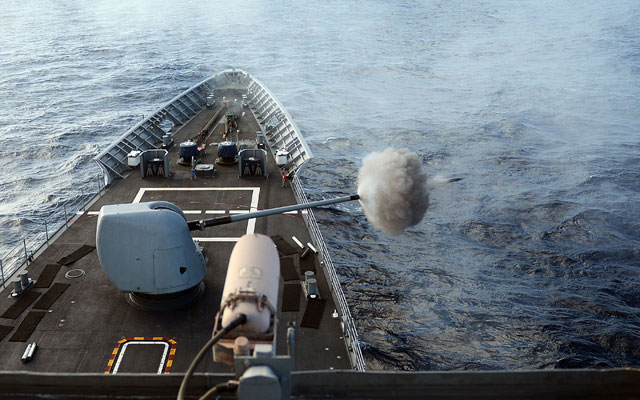The House Armed Services Readiness and Seapower and Projection Forces Subcommittees are holding a joint hearing today to discuss the future of the Navy’s surface fleet.
The Navy is currently juggling sequestration, the pivot to the Asia–Pacific, and unforeseen requirements in the Persian Gulf. Meanwhile, the sea service is also struggling to determine the future of its surface fleet.
One Navy program that has been particularly scrutinized on Capitol Hill and elsewhere is the Littoral Combat Ship (LCS). Originally priced at a little over $200 million per vessel, this brand-new class of ship was intended to be a cost-effective platform to both achieve fleet number goals (58 LCSs are to be built) and combine the capabilities of numerous ships into one flexible platform.
However, the per-ship cost doubled, the flexibility was not as seamless as advertised, and recently the Freedom, the first in class, has suffered a number of maintenance problems while on its first mission in the Pacific. These three questions—cost, utility, and durability—need to be discussed in greater detail before committing to the entire LCS fleet.
The Navy began plans for a new destroyer to replace the legacy DDG-51 in the 1990s with the DDG-1000, which would supposedly be more powerful and versatile. However, as with the LCS, major cost overruns and questions about the ship’s capabilities caused hesitation. As a result, this fleet was reduced to just three vessels.
Instead, the Navy rebooted its DDG-51 program, planning to add some of the new technologies from the DDG-1000. However, this restart has turned out to prove more costly than expected. Furthermore, it is unclear if advanced systems on the DDG-1000 will work in the DDG-51. Before Congress makes a long-term investment in the DDG-51 restart, it needs to better evaluate these concerns.
The aircraft carrier platform has been questioned by some in Congress in recent years. Critics argue that it is a Cold War relic, that it cannot defend itself against new anti-access/area denial threats, and that it is too expensive to continue. Yet these arguments do not acknowledge the carrier’s contributions to security strategy. With new platforms such as the F-35 and the Unmanned Carrier-Launched Airborne Surveillance and Strike system, the carrier’s utility will only increase well into the future. Congress should strive to maintain a sufficient carrier fleet.
The amphibious fleet has been below the Marine Corps’s desired size for a number of years. For the Marine Corps to properly execute its missions, it requires 38 amphibious vessels. However, the fleet has fallen well below that—even before sequestration. As the President increases Marine Corps presence in the Mediterranean in response to incidents such as the Benghazi attack, Congress needs to ensure that this armed service has sufficient fleet support.
As these two subcommittees determine how to fulfill their constitutional responsibility to “provide and maintain a Navy,” they need to carefully evaluate each surface asset and its contribution to executing national security strategy. In fiscally austere times, it has been easy for lawmakers to see large ships as low-hanging fruit to cut out of the budget, but this cannot continue if they wish to continue America’s status as the premier global naval power.
